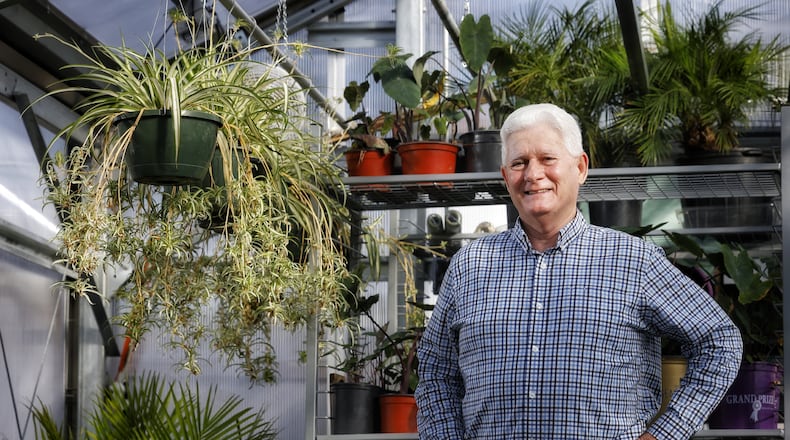“He was the right guy at the right time for the right job, to get us where we needed to be,” said James K. Fitton, chairman of the parks conservancy. “Obviously, I hate to see Steve retire, but he and I are about the same age, so I can certainly understand it’s that time.”
“He just works almost 24/7,” Fitton said. “There aren’t many people like Steve and his work ethic.”
Improving park maintenance
Since Timmer became director of the nonprofit organization Jan. 1, 2015, three new parks were created — Marcum Park near the Great Miami River downtown; Rotary Park at High and North Second streets; and Jefferson Park at 1330 East Ave.
Two others, Beeler Park and Kingston Tot Lot, were reactivated with new playgrounds. And ‘sprayground’ water areas for kids were added at the Booker T. Washington Community Center, Millikin Woods and Crawford Woods, with two water features also added at Marcum Park, which in 2018 was among five added to the list of Great Public Spaces in America.
Modern playgrounds have been added elsewhere, with softer surfaces added beneath them for child safety.
The park system also has improved handicapped access to many parks. At Jim Grimm Park one day, “there was a gentleman there, looked like with his grandkids, but he was in a wheelchair, and he was trying to get to the playground, but it was a struggle,” Timmer said.
“I thought, ‘Darn it, we need to link these up.’ So I hired Cardinal Excavating and we put sidewalks all around the playground and connected to the shelters, and a made a back-way entrance into the spraygrounds. It just made it so much easier. I wish I could do it everywhere.”
It’s been a big job, with 50 parks and natural areas and two golf courses covering about 1,300 acre. There are so many mowers and other equipment operating daily, that when fuel costs rose between 2020 and ‘21, gasoline “cost us $30,000 more than it did in 2020,” Timmer said.
Changes were made
In the years after the Great Recession last decade, Hamilton’s parks were in rough shape.
Fitton says when the city maintained the parks, “no offense to the city, whoever was running it, but it was not their priority. They had other responsibilities as well as managing the parks.”
City Manager Joshua Smith returned from a national convention where he learned conservancies were having success maintaining parks.
He invited Timmer and others to visit Louisville, and later Pittsburgh, where they spent time first visiting city parks, and then the ones kept by conservancies. In both cases, the conservancies managed small numbers of parks, with their cities handling the rest. Hamilton officials and residents were impressed.
At dinner in a Pittsburgh conservancy park, Smith asked Timmer if he were director of a Hamilton conservancy — the first time Timmer said that idea was raised — which ones in the city he would like to manage.
“I said, ‘Well, I’ll be honest with you. I would want them all,’” Timmer said.
Timmer said Smith asked, “What do you mean, want them all?”
“I said, ‘Well, if I fix four or five parks and they’re nice, and someone starts criticizing some of them that aren’t, I’m still going to get blamed for it. And if I’m going to get blamed for something, I want to be the one responsible, so that I can fix it.”
Hamilton’s conservancy, which maintains all city parks, now has 15 full-time employees, a number that increases by dozens during the outdoor season, with some of part-timers working just one or two days a week.
“I couldn’t have a better crew, whether it be in the office or the field,” Timmer said. “They’ll be out there in 10-, 15-degree weather, and they don’t complain and whine. They just go at it.”
He also credits the workers who do jobs like cleaning park restrooms seven days a week, and who were cleaning them every two hours in 2020 because of COVID-19.
He says he’s had two strong superintendents, first Jon Cook, a former firefighter he calls “the hardest working man I’ve ever known in my entire life’'; and the current one, Todd Ream, who “takes care of problems, no problem at all,” often not even letting Timmer know they were problems.
Audrey Baker, who has managed the office the whole time, “keeps me straight, and keeps me on the right road,” he said.
Now also handling golf
In 2020, the conservancy added the city’s municipal golf courses, Twin Run and Potter’s, to the areas it maintained, increasing its budget, with city help, from $2 million to $4.1 million.
That first year, ““Boy, we thought we were going to maybe go bankrupt,” Timmer said. “We took them over, and that’s when COVID hit. At first, they were going to shut the golf courses down, too.”
The conservancy would have had to still mowed, sprayed and tended he courses so they wouldn’t be ruined, he said. Various equipment has been bought and improvements were made, including to sand bunkers and the addition of a pond.
In 2019, 41,556 rounds were played. That rose 30 percent to 54,022 in 2021.
“Sometimes I’ll go back on Golf Adviser and look at some of the ratings of Potter’s in 2019, like in August and September,” which had some low ratings and derogatory comments, he said. “If you look at this year, we get four- and five-star ratings.”
The organization Engaging Local Government Leaders (ELGL) recently named Timmer one of its 2021 Top Influencers in Local Government nationally. He was nominated by his son, Scott Timmer, who was recently hired as Fairfield City Manager.
A lucky leader
Timmer says he has always loved where he worked, from the former Elks Country Club, where he was a caddy, dishwasher and golf-course worker; to the fire department (1978-2011) and the parks conservancy.
The thing that makes him proudest in that career?
“I think them trusting me to do this was pretty big because, hell, they’re trusting a firefighter to take over this multi-million-dollar operation?” he said. “I had a very good construction background, but to have that kind of faith in someone to do that was big.”
He has another point of Hamilton pride: “I was born in Marcum Park,” he said. It’s true, he noted, because “Mercy Hospital used to be there,” he said with his mischievous chuckle.
Timmer, who spent most of his childhood in the Lindenwald neighborhood and graduated from Taft High School in 1973, has lived all but two of his 67 years inside Hamilton, and the others on Old Oxford Road.
Former Hamilton Council Member Kathleen Klink, who helped with creation of the parks conservancy, called Timmer a tireless worker who led his staff by example and was a great motivator. He was able to “stretch the imagination of others,” she said.
“Hamilton parks and Hamilton golf courses are primo, and Steve Timmer is the force behind the successes,” Klink said.
Slowing down to enjoy
Timmer married wife Linda, a West Side girl, 42 years ago at St. Peter’s church in Hamilton. They have two adult children: Ashley is mom to grandsons Jack, 3, and Charlie, 9 months; and son Scott has another grandchild on the way for his father to dote on.
“I think we’ve made a difference, it’s been fun, but I’m kinda wearing out. I’m getting kinda old,” Timmer said.
“If I didn’t have the right people, it wouldn’t have worked. We’ve had adequate funding from the city and the Hamilton Community Foundation jumped behind us.”
Timmer notes the Marcum Family donated money for Marcum Park and also created an endowment for its upkeep.
Frank and Joanne Pfirman, of Matandy Steel fame, donated land that became Jefferson Park.
And the Richard J. Fitton Family Foundation gave a donation for a parks greenhouse to help Janis Hoverholser, the horticulturalist, further use her flowers that make parks beautiful and make golf courses “look like country clubs,” Timmer said.
“We’ve had a lot of really critical people in the community come together to help us with funding that allowed us to do some of these things.”
The top annual contributor is the Hamilton Community Foundation, he said.
“If it wasn’t for the Hamilton Community Foundation, all of these playgrounds wouldn’t have been replaced. They have been absolutely wonderful to the Hamilton parks system.”
The conservancy has hired Adam Cornette, who most recently has worked for the city of Blue Ash. Most recently, Cornette was parks maintenance supervisor for the 130-acre Summit Park.
About the Author

